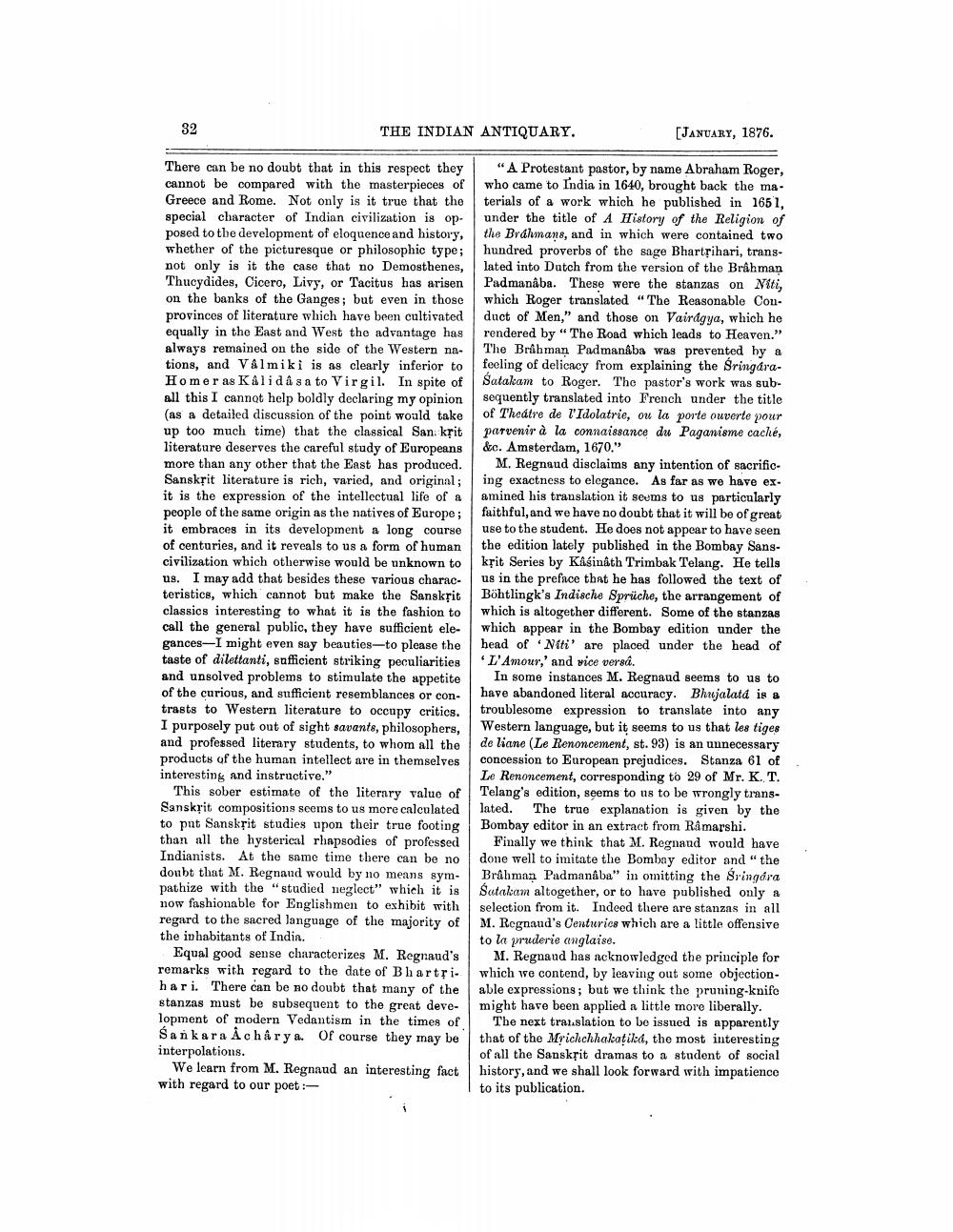________________
32
THE INDIAN ANTIQUARY.
There can be no doubt that in this respect they cannot be compared with the masterpieces of Greece and Rome. Not only is it true that the special character of Indian civilization is opposed to the development of eloquence and history, whether of the picturesque or philosophic type; not only is it the case that no Demosthenes, Thucydides, Cicero, Livy, or Tacitus has arisen on the banks of the Ganges; but even in those provinces of literature which have been cultivated equally in the East and West the advantage has always remained on the side of the Western nations, and Valmiki is as clearly inferior to Homer as Kâlidâ sa to Virgil. In spite of all this I cannot help boldly declaring my opinion (as a detailed discussion of the point would take up too much time) that the classical San krit literature deserves the careful study of Europeans more than any other that the East has produced. Sanskrit literature is rich, varied, and original; it is the expression of the intellectual life of a people of the same origin as the natives of Europe; it embraces in its development a long course of centuries, and it reveals to us a form of human civilization which otherwise would be unknown to us. I may add that besides these various characteristics, which cannot but make the Sanskrit classics interesting to what it is the fashion to call the general public, they have sufficient elegances I might even say beauties-to please the taste of dilettanti, sufficient striking peculiarities and unsolved problems to stimulate the appetite of the curious, and sufficient resemblances or contrasts to Western literature to occupy critics. I purposely put out of sight savants, philosophers, and professed literary students, to whom all the products of the human intellect are in themselves interesting and instructive."
This sober estimate of the literary value of Sanskrit compositions seems to us more calculated to put Sanskrit studies upon their true footing than all the hysterical rhapsodies of professed Indianists. At the same time there can be no doubt that M. Regnaud would by no means sympathize with the "studied neglect" which it is now fashionable for Englishmen to exhibit with regard to the sacred language of the majority of the inhabitants of India.
Equal good sense characterizes M. Regnaud's remarks with regard to the date of Bhartrihari. There can be no doubt that many of the stanzas must be subsequent to the great development of modern Vedantism in the times of Sankara Acharya. Of course they may be interpolations.
We learn from M. Regnaud an interesting fact with regard to our poet :
[JANUARY, 1876.
"A Protestant pastor, by name Abraham Roger, who came to India in 1640, brought back the materials of a work which he published in 1651, under the title of A History of the Religion of the Brahmans, and in which were contained two hundred proverbs of the sage Bhartrihari, translated into Dutch from the version of the Brahman Padmanaba. These were the stanzas on Niti, which Roger translated "The Reasonable Conduct of Men," and those on Vairagya, which he rendered by "The Road which leads to Heaven." The Brahman Padmanaba was prevented by a feeling of delicacy from explaining the ŚringáraSatakam to Roger. The pastor's work was subsequently translated into French under the title of Theatre de l'Idolatrie, ou la porte ouverte pour parvenir à la connaissance du Paganisme caché, &c. Amsterdam, 1670."
M. Regnaud disclaims any intention of sacrificing exactness to elegance. As far as we have examined his translation it seems to us particularly faithful, and we have no doubt that it will be of great use to the student. He does not appear to have seen the edition lately published in the Bombay Sanskrit Series by Kâsinâth Trimbak Telang. He tells us in the preface that he has followed the text of Böhtlingk's Indische Sprüche, the arrangement of which is altogether different. Some of the stanzas which appear in the Bombay edition under the head of Niti' are placed under the head of L'Amour,' and vice versa.
In some instances M. Regnaud seems to us to have abandoned literal accuracy. Bhujalatá is a troublesome expression to translate into any Western language, but it seems to us that les tiges de liane (Le Renoncement, st. 93) is an unnecessary concession to European prejudices. Stanza 61 of Le Renoncement, corresponding to 29 of Mr. K. T. Telang's edition, seems to us to be wrongly translated. The true explanation is given by the Bombay editor in an extract from Râmarshi.
Finally we think that M. Regnaud would have done well to imitate the Bombay editor and "the Brahman Padmanâba" in omitting the Śringára Satakam altogether, or to have published only a selection from it. Indeed there are stanzas in all M. Regnaud's Centuries which are a little offensive to la pruderie anglaise.
M. Regnaud has acknowledged the principle for which we contend, by leaving out some objectionable expressions; but we think the pruning-knife might have been applied a little more liberally.
The next translation to be issued is apparently that of the Mrichchhakatiká, the most interesting of all the Sanskrit dramas to a student of social history, and we shall look forward with impatience to its publication.




